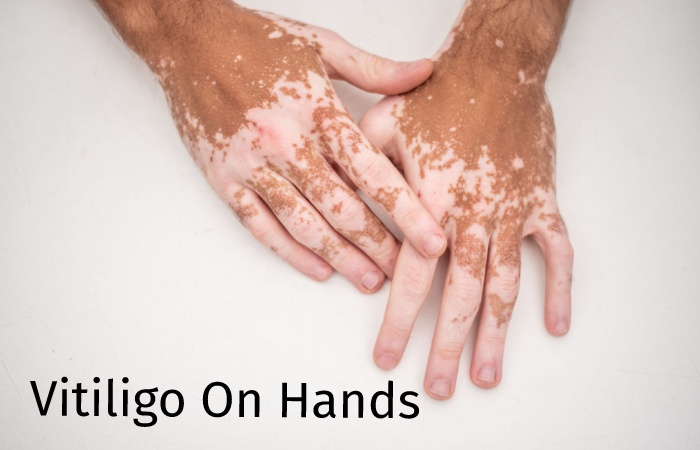The skin disease vitiligo (white spot disease) is characterized by those affected by characteristic white spots that are sharply delimited from the surrounding skin. A particularly well-known example of an affected person is supermodel Winnie Harlow, the white patches on her dark skin are a kind of trademark on her.
Table of Contents
What Is Vitiligo?
Typical of the appearance of Vitiligo is the already mentioned white (depigmented) skin areas, which can appear isolated or over a large extent on the whole body. However, an essential aspect first: the disease is neither contagious nor dangerous for those affected.
The chronic disease usually occurs for the first time between the ages of 10 and 30 and spreads over the years. If new spots appear, this can also be associated with itching in rare cases. If the white spots form on the scalp, for example, the hair growing there can also turn white.
Are There Different Forms Of Vitiligo?
Vitiligo can be divided into two categories: On the one hand, when it occurs, i.e., at what stage of life/age or according to the localization of the spots. On the other hand, two types can be distinguished in each group. Let’s start with the differentiation according to the temporal occurrence of the disease:
Type 1 (Before Puberty) – This is the rarer form, occurring in only about 15% of people affected. Here, the first pigment-free spots appear on the skin before Puberty, i.e., primarily in childhood. Many patients are also affected by neurodermatitis and have many birthmarks and gray hair in some places.
Type 2 (After Puberty) – This white spot disease only begins after Puberty, and there is no direct connection with neurodermatitis, birthmarks, or gray hair.
Vitiligo – Localization And Spread Of The Pigment-Free Areas
Localized Vitiligo – Only isolated white spots appear here on the body.
Within this spectrum of diseases, other types can again be distinguished:
Vitiligo Vulgaris – This is the most common form of Vitiligo. Large white spots appear on various parts of the body.
Non-Segmental Vitiligo – Both body halves are equally affected; some spots can appear symmetrical.
Segmental Vitiligo – In this form, the white patches usually only appear on one side.
Vitiligo Acrofacialis – The areas without pigment are limited to the facial region, hands, and feet.
Vitiligo Generalis – More than 80% of the entire skin is pigmented.
Why Do You Get Vitiligo?
The exact cause of Vitiligo is not clear. Familial accumulation is observed, which is why a genetic predisposition is suspected. However, the disease does not necessarily have to be passed on to the children. In addition, one assumes an autoimmunological component, i.e., a dysregulation in one’s body. Even if the cause is not completely clear, some factors are known that can promote flare-ups, i.e., spread. These include
- Stress.
- Physical strain.
- Skin injuries.
- Sunburn.
- Skin irritation.
The mechanism that “colors” the skin white is as follows: Our body contains specific skin cells, the melanocytes, which are responsible for the production of the skin pigment melanin. In addition to coloring the skin, melanin is also responsible for coloring the eyes and hair. Patients with Vitiligo, or their melanocytes, no longer produce any melanin on the affected skin areas so that the skin becomes pigments, i.e., white. This process is probably the result of the above-mentioned disturbance within one’s immune system.
Can Vitiligo Regress?
Vitiligo cannot be cured, but the flare-ups can be significantly reduced or even stopped entirely with the proper treatment. In the best case, melanin production can be stimulated. Patients have a variety of options to do this. First, avoiding possible trigger factors such as stress, excessive physical exertion, or skin irritation is essential. More importantly, people affected by Vitiligo should always wear high sunscreen, no matter the time of year.
There are also various medical therapy options, such as phototherapy. This light therapy with UV light is suitable if the spots are located in unique places. Here the bright spots are irradiated with the UV light. The aim is to stimulate melanin production again and to color the skin.
However, no satisfactory result can be guaranteed with either treatment, even if the patients respond to the therapy. Therefore, it is also essential that a doctor should accompany these therapies.
In addition, there are other forms of light therapy, and drug treatment is also possible. Thorough doctor-patient communication is essential to finding a suitable therapy approach that is as promising as possible.
Conclusion
Very often, dark pigment spots and the white spots of Vitiligo lumps together and commonly refers to as pigment spots. One can even almost say that these are opposite appearances. Dark pigment spots are due to hyperpigmentation, i.e., an overproduction of melanin, which causes dark spots to appear on the skin.
